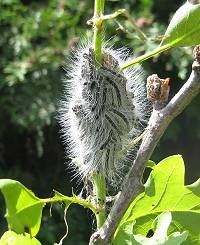I wrote previously about a looming threat to man and trees from the oak processionary moth (OPM) that first appeared in the UK in 2006. It is a widespread pest in The Netherlands, Germany and Belgium.

I am grateful to Ron Melville, Director of Forestry Commission London, for sharing the following (below) Management Implications with me. Ron recently returned from a visit with Forest Research colleagues to Germany where the pest is a serious issue; perhaps a herald of things to come in the UK. Forest workers that had been involved in managing stands with OPM had all suffered from ‘rash’ problems, and difficulties of working in infected woods remained six years after an outbreak has passed. For example, one forester required hospital treatment after handling a log cut during clearance work six years previously.
Some important management implications for forest workers
- OPM has the potential to be not only a problem relating to open-grown mature oak trees, but also in younger plantation crops.
- Although oak is the preferred host tree species, OPM has been recorded in plantations of beech and hornbeam, and in orchard apples.
- OPM is a serious defoliator and with no control there is no doubt that tree’s leaves will be drastically removed. This will weaken the tree and if it doesn’t kill it directly, it will increase its susceptibility to attack from wood borers and possibly root pathogens, which will damage and kill the tree. In one German P1960 stand of Red Oak visited by Melville and colleagues, 75% of trees had been infected and removed.
- New nests are very obvious but previous year’s or older nests are less visible as they fade in colour. Close inspection is always needed to ensure absence of danger.
- It is difficult to imagine how spraying control pesticides in UK plantations could be achieved without the use of helicopters. Could this be justified financially (costs are in order of €230 per hectare)?
- Assuming helicopter spraying is not feasible in the UK, then control options within closed woodland are extremely limited. Vacuuming is an option for individual trees in urban areas, parks and gardens (costs €60-2000). However, the cost and difficulties of using the equipment in plantations are likely to prove insurmountable.
- Re-invasion in areas if left untreated appears to be considerable. Unless there is full and complete removal of nests or control of caterpillars, the treatment may ultimately be ineffective.
- The longevity of the hairs in the environment and related health problems could be a serious issue, not just for forest workers, but also for any indirect handling of logs or other cut material (e.g. lop and top for biomass or chipping).
- OPM caterpillar populations can reach significant levels in mature oak stands. In the UK, these are likely to be the areas with highest public usage. This is potentially a very serious problem for human health and for forest management.
Gabriel Hemery
 This work is licensed under a Creative Commons Attribution- NonCommercial- NoDerivs 3.0 United States License.
This work is licensed under a Creative Commons Attribution- NonCommercial- NoDerivs 3.0 United States License.
